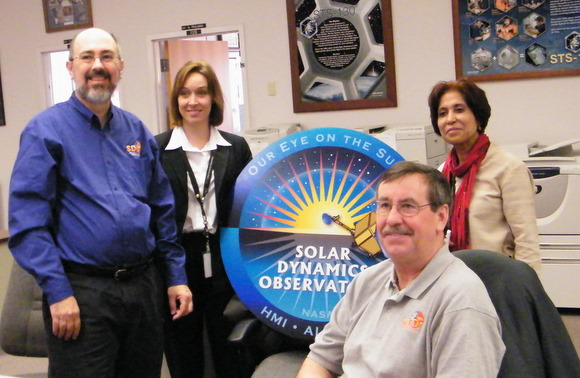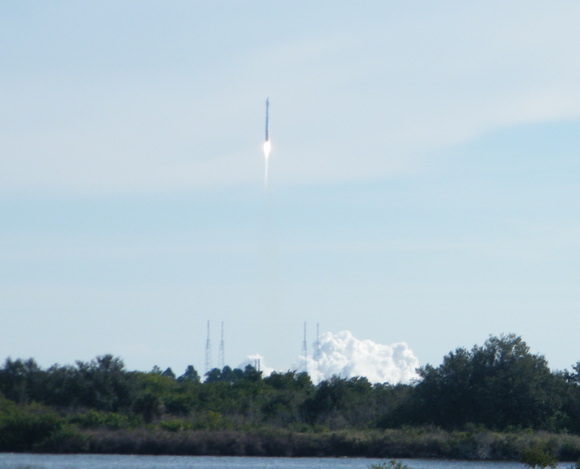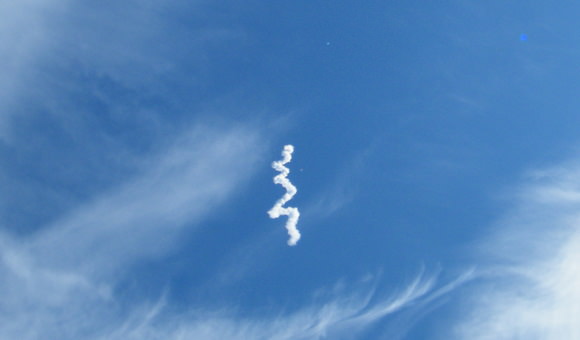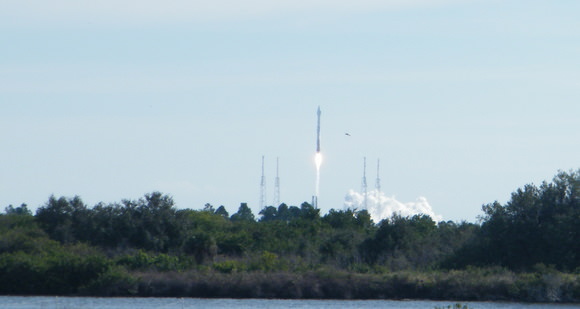The Solar Dynamics Observatory launched successfully – and beautifully – Thursday morning from Cape Canaveral Launch Complex 41 to begin a 5-year mission that will provide streaming, high-definition views of our sun. It was the 100th launch of the Atlas/Centaur combo, and was a gorgeous sight as it roared and soared into the blue Florida sky. “It was great; a beautiful launch,” said Dean Pesnell, SDO Project Scientist, immediately after the launch. “The rocket rises so slowly off the pad — it is wonderful to see. This is third Atlas launch I’ve seen and this is the best one so far.”
Amazingly, viewers here at Kennedy Space Center saw the Atlas rocket fly close to a sundog just as the spacecraft reached Max-Q, creating a ripple effect around the spacecraft. “We saw this sundog come out and SDO flew right through it. Then the sun dog disappeared,” said Pesnell. “This may be the first time we’ve sent a probe through a sundog, and people will be studying this, so already we are learning things about our atmosphere from SDO.”
See this amazing video shot by a 13-year-old girl in attendance at the KSC VIP site that shows the sundog and shockwave. (as noted by Jon Hanford in the comments).
Today’s countdown was extremely smooth as the high winds that thwarted Wednesday’s launch attempt calmed as the opening of the launch window approached. After counting down to the planned T-4 minute hold, launch managers proceeded directly to launch at the beginning of the window at 10:23 a.m. EST.

“I was a little worried about the clouds coming in,” said Tom Woods, Principal Investigator for the EVE instrument on SDO, the EUV Variability Experiment, which will be studying the extreme ultraviolet radiation of the Sun. “But we were very excited to see SDO launch today, as otherwise it would have been a 10-day delay until the next attempt. It was a wonderful launch!”
“It was so beautiful,” said Lika Guhathakurta, SDO program scientist immediately following the launch as we walked together back to the press building. “I can still feel the rumbling in my stomach!”

Called the “Crown Jewel” of NASA’s fleet of solar observatories, SDO is a technologically advanced spacecraft that will take images of the sun every 0.75 seconds and daily send back about 1.5 terabytes of data to Earth — the equivalent of downloading 380 full-length movies every day.

“We’re going to be able to better understand the Sun as a star,” said Guathakurta, “but SDO will also give us a comprehensive view of how it interacts with the Earth and everything else in the solar system.
The sun’s dynamic processes affect everyone and everything on Earth. SDO will explore activity on the sun that can disable satellites, cause power grid failures, and disrupt GPS communications. SDO also will provide a better understanding of the role the sun plays in Earth’s atmospheric chemistry and climate.

A contrail from the launch appeared only in the region of Earth’s atmosphere where conditions were right for cloud formation. “There weren’t any clouds there, but we provided the very fine particles so that a contrail cloud appeared,” said Pesnell.
A later update confirmed that SDO separated from the Centaur and the spacecraft’s solar arrays deployed on time and correctly, and are now generating power.
Here’s the video of the launch from NASA TV:


Love your launch shots, Nancy – almost surreal, just looking at them and knowing that you were right there, living in that moment, recording history. That must have been a very special experience!
Do you know if anyone got any pictures of the sundog moment? I saw Tony Hoffman’s picture (http://twitpic.com/12m2bu) – I wonder if there are others, maybe with the rocket appearing even closer to the sundog.
I not jealous… envious perhaps, but not jealous. (Warm down there?) TWO launches in one trip! NICE!
Interesting that ‘Max ‘Q’ and contrail generation occurred at approx. the same time…Correlation?
Ditto Tavi’s comments. That must have been an awesome experience. I’m curious though, how did the sound compare to that of the shuttle launch? Louder, longer?
Caught sight of the sundog in several of the launch replays. How fitting for a solar observatory! Great pics, Nancy.
Thanks, Tavi and Jon! It was such a great privilege to watch the launch (amazing!) and be able to talk to the mission scientists right afterwards. What a rush!
A most excellent Quicktime video of SDO punching through the sundog-producing layer in the atmosphere (w-ripples visible) by 13 year-old Anna Herbst [courtesy SpaceWeather.com]: http://www.spaceweather.com/swpod2010/11feb10/anna-herbst1.mov . Oh yeah! 🙂
Jon- thanks for that video link! Amazing! I’ve added the link in the article. The video shows it exactly as I saw it. Great capture!
Nancy – thanks for your help on Astronomy.FM, for both the launch attempt, and the launch itself! It was wonderful of you to take the time to share your experiences with our audience. Thanks! ~Michael
Hey Nancy … I am so proud of you and the work you do. Right now there isn’t a single state in the nation that doesn’t have snow on the ground or in the air!! Something that rarely occurs. You picked a great time to go to Florida!! Hope each moment is memorable. Love Ya!
Thanks everyone for all the love!
~Nancy